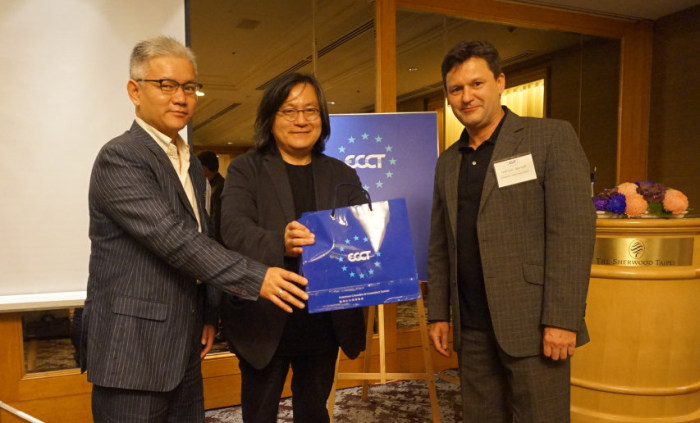Urban development in Taipei City

On 8 April 2016 the ECCT's Energy & Environment committee hosted a lunch with guest speaker Lin Jou-min, Commissioner of the Department of Urban Development in the Taipei City Government on the topic "A city like ours - Building Taipei with a human touch". Lin shared some of his experiences as a commissioner, visions and development plans of the Taipei City Government under the administration of Mayor Ko Wen-jo.
Lin had practiced as an architect since 1984 before being approached by Mayor Ko to take on the position of commissioner in charge of urban development in Taipei City. By taking on the role, Lin is the first architect to be appointed to run the city's department of urban development. This has brought a unique perspective and expertise to issues of urban development, based on his considerable experience.
During his career Lin has taken on a number of difficult and challenging redesign, renovation and retrofitting projects. For example, Lin's firm has retrofitted a dormitory into a college of education. One of his most visionary projects was to convert an old coal-fired power plant into a museum of marine science. That project, which took eight years, was able to combine some of the elements and feel of the power plant while also creating a connection to the ocean, since it was essential for a marine science museum to have a view of the ocean. This required raising the original structure and creating a glass wall along the entire front side of the building.
Many of the projects taken on by his firm have been public projects, which require both expertise as well as good communication with all stakeholders. Lin admitted that while the numerous public hearings and debates with citizens required in his new role are not his favourite part of the job, they are necessary to convince those involved that his plans are in the best interests of the city and its citizens.
Even though a city mayor has a maximum of two terms or eight years in office and there is a limit to what can be achieved in the short term, Lin believes it is important to have a long-term vision for the future and to take action to realise that vision, even if it cannot be completed in the near term. Lin is well aware that he has a limited time to make a difference, which is he is not wasting any time. His plans are very ambitious. For example, his department has identified 46 sites in the city and plans to build 20,000 public housing units in the near term and up to 50,000 in the medium term. This he said was necessary because public housing in Taipei only accounts for 0.68% of housing stock, compared to Seoul, where it is 5%, Berlin, where it is 6% and some places in The Netherlands where it is over 30%. He also has plans to enhance green spaces and connect people with nature, such as building raised riverside walkways.
A lot of thinking has gone into developing a workable and financially-sound business model for urban renewal that is cost-effective, makes the best use of public land, creates public housing units while also benefiting developers and making the city a better place to live at the same time.
In addition, urban renewal creates a lot of jobs for planners, designers, developers and construction companies, which in turn create a multiplier effect for the economy.
Lin also sought to dispel the notion that architects cannot plan road routes, giving an example of a road design that he said would significantly improve traffic flow in one part of the city.
It is Lin's view that Songshan Airport should be turned into a central park that would be the envy of New York's central park. He has already presented designs for such a park.
In the Q&A session Lin was asked whether so-called "mosquito halls" (abandoned and disused buildings) in the city could be converted to public housing units. Lin said that in most cases these buildings were in such poor condition that it would not make sense to devote much effort and money to make them safe and then convert them into what would be only be average housing units. In most cases, it would be better to demolish them and build good units from scratch. However, he said that it may be possible, in some cases, to convert unused school buildings into public housing units.
